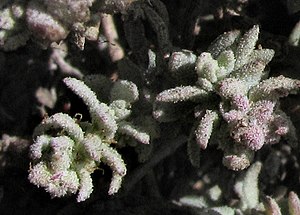Extriplex
| Extriplex | ||||||||||||
|---|---|---|---|---|---|---|---|---|---|---|---|---|

|
||||||||||||
| Systematics | ||||||||||||
|
||||||||||||
| Scientific name | ||||||||||||
| Extriplex | ||||||||||||
| EH Zacharias |
Extriplex is a genus of plants from the subfamily Chenopodioideae in the foxtail family(Amaranthaceae). It was described in 2010 and contains two species from California that were previously placed in the genus Atriplex .
description
Appearance and leaves
The Extriplex species are annual or perennial herbaceous plants that grow upright, spread out, or prostrate, and reach heights of 10 to 100 centimeters. Young plants are floury, the older ones are bald or appear scaly. The young, striped, later straw-colored shoot axes are strongly or weakly branched.
The alternate (below sometimes almost opposite) leaves can be sessile or stalked. The green or grayish leaf blades are 4 to 70 millimeters long and 2 to 40 millimeters wide, triangular to ovate-rhombic or lanceolate to elliptical. The leaf margin is irregularly serrated or has entire margins. The leaf anatomy corresponds to the "normal" (non-wreath) type of C3 plants .
Inflorescences and flowers
The Extriplex species are single- sexed ( monoecious ). In the axillary inflorescences, male and female flowers are usually mixed, whereas in the terminal, pseudo-eared or paniculate, interrupted or dense inflorescences, they are often separated. The male flowers (with cover sheet) have a perimeter of four rounded-triangular tepals 1 millimeter long with a hood-like tip, connected in the lower quarter to half of each other . In front of the tepals there are four stamens that arise from a discus . The anthers do not protrude from the flower. The female flowers sit between two bracteoles , they have no flower cover and only consist of an ovary with two thread-like, protruding stigmas.
The Extriplex species bloom in their natural range from April to November.
Fruits and seeds
At the time of fruiting, the enveloping pre-leaves grow to 3 to 4.5 millimeters long and 2 to 3 millimeters wide. They are free or connected in the lower half. Their shape is egg-shaped, almost round or triangular, with entire margins and pointed at the end. Their surface can be densely scaled, smooth or ribbed. The ripe fruit, which remains enclosed by the bracts, does not fall off. It is almost spherical or laterally compressed, its membranous pericarp is free or only loosely adheres to the seed. The vertically standing seed has a black to dark brown, smooth and shiny, hard seed coat. The ring-shaped embryo surrounds the abundant, floury endosperm .
Sets of chromosomes
The chromosome numbers given are n = 9 ( haploid ) and 2n = 18 ( diploid ).
Occurrence
The genus Extriplex is only native to the Mediterranean climate on the Pacific coast of the USA (California Floral Province) and in the coastal deserts of Baja California . It occurs in the California Long Valley (Central Valley) and the valleys of the inner coastal mountains and is common north of San Francisco to Isla de Cedros (Baja California).
Extriplex inhabits sandy coasts, bushland and salt marshes. The two species differ in their habitats : Extriplex californica often forms pure stocks in coastal habitats and often grows on sandy soil. Extriplex joaquinana , on the other hand, is found inland in bushes or grasslands on alkaline soil.
Systematics
The first description of the genus extriplex was made in 2010 by Elizabeth H. Zacharias (In: A Molecular Phylogeny of North American Atripliceae (Chenopodiaceae), with Implications for Floral and Photosynthetic Pathway Evolution . In: Systematic Botany 35 (4), pp 839-857) . The genus was established to separate two species from the genus Atriplex , which had proven to be phylogenetically independent. The generic name is derived from the Latin prefix "ex" (= from, out) and the generic name Atriplex . The type species is Extriplex joaquinana .
Synonyms for Extriplex E.H. Zacharias are Atriplex [unrated] Californicae Standl. and Atriplex subsect. Californicae (Standl.) SL Welsh .
Extriplex belongs to the tribe Atripliceae of the subfamily Chenopodioideae in the family Amaranthaceae .
The genus includes two types:
- Extriplex californica (Moq.) EHZacharias (Syn .: Atriplex californica Moq. ): This species is called "California saltbush" or "California orach".
- Extriplex joaquinana (A.Nelson) EHZacharias (Syn .: Atriplex joaquinana A.Nelson ): This species is called "San Joaquin saltbush" and "San Joaquin orach".
swell
- Elizabeth H. Zacharias, Bruce G. Baldwin: A Molecular Phylogeny of North American Atripliceae (Chenopodiaceae), with Implications for Floral and Photosynthetic Pathway Evolution . In: Systematic Botany 35 (4), 2010, pp. 839-857. doi : 10.1600 / 036364410X539907 (sections description, occurrence, systematics)
Individual evidence
- ↑ Atriplex californica in the Integrated Taxonomic Information System (ITIS)
- ↑ Stanley L. Welsh (2003): Atriplex californica - text online with the same text as the printed work , In: Flora of North America Editorial Committee (ed.): Flora of North America North of Mexico . Volume 4: Magnoliophyta: Caryophyllidae, part 1 . Oxford University Press, New York / Oxford a. a. 2003, ISBN 0-19-517389-9 , pp. 366 (English).
- ↑ Atriplex joaquiniana in the Integrated Taxonomic Information System (ITIS)
- ^ Stanley L. Welsh (2003): Atriplex joaquiniana - text online with the same text as the printed work , In: Flora of North America Editorial Committee (Ed.): Flora of North America North of Mexico . Volume 4: Magnoliophyta: Caryophyllidae, part 1 . Oxford University Press, New York / Oxford a. a. 2003, ISBN 0-19-517389-9 , pp. 335 (English).